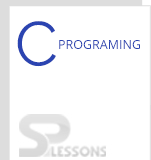 Description
Description
Error is something which disturbs the flow of execution of a program. Handling these errors is called as C Error Handling.
 Error Types
Error Types
Basic type of errors
- Semantic error: occurs due to improper use of program statements.
- logical error: occurs due to mistakes in logical declarations.
- Syntax error: occurs when syntax is not properly specified.
 More Info
More Info
There are few errors which cannot be detected by the compiler. They are:
As these errors are not identified by the compiler, they are termed as "Exceptions". Exceptions occurs during the time of execution of the program.
- Run-time errors.
- Compile time errors.
- Errors occur at "run time" and "compile time" but, Exceptions occurs mostly at "run-time".
- Programmer itself should detect the exception. Errors can be handled by the compiler.
- C Error Handling is easier than exception handling.
 Description
Description
Ignoring the errors is unprofessional which may lead to many other errors, if not handled at proper time.
 Description
Description
Terminating the program is really worst when compared to the above one. When there occurs an unavoidable error, which cannot be recovered again, then the program gets terminated indirectly leading to loss of data.
For example, when any number divided by zero results in infinity, which is not taken by the compiler. In that case, the program gets terminated. exit() function is specified in
stdlib directory.  Example
Example
[c]
#include<stdio.h>
#include<conio.h>
#include<math.h>
{
int a=12;
int b=0;
c=a/b;
printf(" The program is terminating");
}[/c]
 Description
Description
When an error indicator is set in the program, compiler raises a signal whenever an error occurs disturbing the normal flow of program execution.
To handle all of these signals, we need to define "signal.h" as the header file. When an error occurs in the execution, a signal() function is called and checks in 'signal.h' for handling the respective error.
 Example
Example
[c]
#include <signal.h>
#include <stdio.h>
#include <stdlib.h>
void mistake(int signal)
{
puts("signal caught");
}
int main(void)
{
if (signal(x,y) == sig_err)
{
fputs("Error occurred when setting a signal handler\n", stderr);
return EXIT_FAILURE;
}
puts("Raising the signal.");
if (raise(x) != 0)
{
fputs("Error raising the signal\n", stderr);
return EXIT_FAILURE;
}
puts("exit");
return 0;
}[/c]
 Description
Description
As seen in second way, the program gets terminated without any prior intimation. Here, that problem overcomes by giving an error message and then exits finally.
 Example
Example
[c]
#include <stdio.h>
#include <stdlib.h>
int main()
{
int a= 12;
int b= 0;
int c;
if (b == 0) // calls stderr
{
fprintf("cannot divide by zero\n",stderr);
exit(EXIT_FAILURE);
}
c=a/b;
exit(EXIT_SUCCESS);
}[/c]
 Description
Description
setjmp() and longjmp() functions can be used to move away from a location into other function until the error gets rectified.
- Whenever a error occurs,setjmp() is called.
- Till then the recent work done can be stored in buffer called "jmp buf". If checking of exception completes, setjmp() returns zero to longjmp().
- Immediately execution carries on from the point where it was stopped earlier.
 Example
Example
[c]
#include<stdio.h>
#include<setjmp.h>
#include<stdlib.h>
int main()
{
int a=10;
int b;
int c;
jmp_buf env;
printf("Enter the dividend value b\n");
setjmp(env);// This stores the value of scanf() in buffer
scanf(%f",&b);
if(b==0)
longjmp(env,2); // goes to where we stopped
c=(a/b);
printf(%.2f\n", c);
exit(EXIT_SUCCESS);
return 0;
}[/c]
 Key Points
Key Points
- Errors stops the flow of program.
- One can set error signals or call exit function or use setjmp(), longjmp() functions to handle errors.
 Programming
Tips
Programming
Tips
setjmp() function leads to loss of code.



